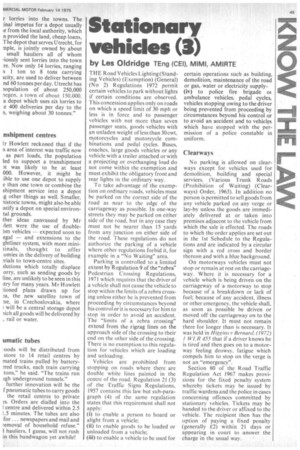Stationary vehicles (3)
Page 47

If you've noticed an error in this article please click here to report it so we can fix it.
by Les Oldridge TEng (CEO, MIMI, AMIRTE THE Road Vehicles Lighting (S tanding Vehicles) (Exemption) (General) (No 2) Regulations 1972 permit certain vehicles to park without lights if certain conditions are observed. This concession applies only on roads on which a speed limit of 30 mph or less is in force and to passenger vehicles with not more than seven passenger seats, goods vehicles with an unladen weight of less than 30cwt, motorcycles and motorcycle combinations and pedal cycles. Buses, coaches, large goods vehicles or any vehicle with a trailer attached or with a projecting or overhanging load do not come within the exemption and must exhibit the obligatory front and rear lights in the ordinary way.
To take advantage of the exemption on ordinary roads, vehicles must be parked on the correct side of the road as near to the edge of the carriageway as possible. In one-way streets they may be parked on either side of the road, but in any case they must not be nearer than 15 yards from any junction on either side of the road. These regulations do not authorize the parking of a vehicle where other regulations forbid it, for example in a "No Waiting" area.
Parking is controlled to a limited extent by Regulation 9 of thezebra" Pedestrian Crossing Regulations, 1971 which requires that the driver of a vehicle shall not cause the vehicle to stop within the limits of a zebra crossing unless either he is prevented from proceeding by circumstances beyond his control or it is necessary for him to stop in order to avoid an accident. The "limits of a zebra crossing" extend from the zigzag lines on the approach side of the crossing to their end on the other side of the crossing. There is no exemption to this regulation for vehicles which are loading and unloading.
Vehicles are prohibited from stopping on roads where there are double white lines painted in the centre of the road. Regulation 21(3) of the Traffic Signs Regulations, 1957 contains this law but sub-paragraph (4) of the same regulation states that this requirement shall not apply: (I) to enable a person to board or alight from a vehicle: (ii) to enable goods to be loaded or unloaded from a vehicle;
(iii) to enable a vehicle to be used for
certain operations such as building, demolition, maintenance of the road or gas, water or electricity supply(iv) to police fire brigade m ambulance vehicles, pedal cycles, vehicles stopping owing to the driver being prevented from proceeding by circumstances beyond his control or to avoid an accident and to vehicles which have stopped with the permission of a police constable in uniforim
Clearways
No parking is allowed on clearways except for vehicles used for demolition, building and special services. (Various Trunk Roads (Prohibition of Waiting) (Clearways) Order, 1963). In addition no person is permitted to sell goods from any vehicle parked on any verge or lay-by unless the goods are immediately delivered at or taken into premises adjacent to the vehicle from which the sale is effected. The roads to which the order applies are set out in the 1st Schedule to the Regulations and are indicated by a circular sign with a red cross and border thereon and with a blue background.
On motorways vehicles must not stop or remain at rest on the carriageway. Where it is necessary for a vehicle which is being driven on the carriageway of a motorway to stop because of a breakdown or lack of fuel; because of any accident, illness or other emergency, the vehicle shall, as soon as possible be driven or moved off the carriageway on to the hard shoulder. It must not remain there for longer than is necessary. It was held in Higgins v Bernard, (1972) I WI.R 455 that if a driver knows he is tired-and then goes on to a motorway feeling drowsy, fatigue which compels him to stop on the verge is not an "emergency".
Section 80 of the Road Traffic Regulation Act 1967 makes provisions for the fixed penalty system whereby tickets may be issued by traffic wardens and the police in cases concerning offences committed by stationary vehicles. Tickets may be handed to the driver or affixed to the vehicle. The recipient then has the option of paying a fixed penalty (generally €.2) within 21 days or appearing in court to answer the charge in the usual way.




































































































